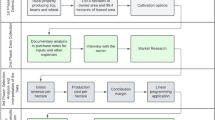Abstract
Managing resources efficiently is essential in order to minimize the cost of operation of a company which produces products or services. In agriculture, farmers also need to allocate their resources such as land, labour hours, machinery and seedlings to avoid wastage. However, most farmers lack the knowledge on practical methods to allocate their resources. In this study, the linear programming approach was employed as a means to allocate the area of land for rubber, calamansi, harumanis and kelapa matag. This study also aimed to determine an optimal combination of crops among the selected crops that can maximize the annual revenue. The result was then compared with the traditional method. There were nine constraints of resources involved such as land, labour hours, machinery, pesticides, solid and liquid fertilizers, solid and liquid insecticides and seedlings. Based on the results, the best allocation was 11.34 and 11.51 acres of land for rubber and harumanis, respectively. However, calamansi and kelapa matag do not contribute high revenue and should be omitted from the system. The annual revenue obtained using the linear programming method also increased by 5% compared to the traditional method. Hence, the linear programming method proved to be the best method to allocate the limited resources in agriculture in order to maximize the revenue.
Access this chapter
Tax calculation will be finalised at checkout
Purchases are for personal use only
Similar content being viewed by others
References
Abdus, S., Abedullah, M. A., & Shahzad, K. (2010). Economics of conventional and partial organic farming systems and implications for resource utilization in Punjab (Pakistan). Pakistan Economic and Social Review, 48(2), 245–260.
Ibrahim, H. (2007). Determining optimal maize-based enterprise in Soba local government area of Kaduna State, Nigeria. Journal of Agriculture, Food, Environment and Extension, 6(2), 1–5.
Issa, P., Habib, P., Majid, D., Mehdi, D., & Abolfazi, G. (2011). Performance evaluation of agricultural inputs in crops production of Zahak Payame Noor University agricultural faculty farm by linear programming. Journal of Development and Agricultural Economics, 3(3), 107–112.
Majeke, F., & Majeke, J. (2010). A farm resource allocation problem: Case study of small scale-commercial farmers in Zimbabwe. Journal of Sustainable Development in Africa, 12(2), 315–320.
Majeke, F., Majeke, J., Mufandaedza, J., & Shako, M. (2013). Modelling a small farm livelihood system using linear programming in Bindura, Zimbabwe. Research Journal of Management Sciences, 2(5), 20–23.
Masoud, S. (2013). The simplex method for solving fuzzy number linear programming problem with bounded variables. Journal of Basic and Applied Scientific Research, 3(3), 618–625.
Oni, N. O., Osuntoki, N. B., Rahaman, A., & Amao, O. D. (2013). Profit maximization among dry season vegetable farmers. African Journal of Mathematics and Computer Science Research, 6(4), 72–76.
Sen, N., & Nandi, M. (2012). A goal programming approach to rubber-tea intercropping management in Tripura. Asian Journal of Management Research, 3(1), 178–183.
Sharma, D. K., Jana, R. K., & Gaur, A. (2007). Fuzzy goal programming for agricultural land allocation problems. Yugoslav Journal of Operations Research, 17(1), 31–42.
Tanko, L., Baba, K. M., & Adenji, O. B. (2011). Analysis of the competitiveness of mono-crop and mixed crop enterprises in farming system of smallholder farmers in Niger State, Nigeria. International Journal of AgriScience, 1(6), 344–355.
Zira, B. D., & Ghide, A. A. (2013). Illustrative optimal portfolio selection for agroforestry crops: A linear programming approach. International Journal of Management and Social Sciences Research, 2(8), 139–141.
Author information
Authors and Affiliations
Corresponding author
Editor information
Editors and Affiliations
Rights and permissions
Copyright information
© 2018 Springer Nature Singapore Pte Ltd.
About this paper
Cite this paper
Baharom, N., Bakar, N.A.A. (2018). The Optimization of Crop Production: A Case Study at the Farming Unit of UiTM Perlis. In: Saian, R., Abbas, M. (eds) Proceedings of the Second International Conference on the Future of ASEAN (ICoFA) 2017 – Volume 2. Springer, Singapore. https://doi.org/10.1007/978-981-10-8471-3_66
Download citation
DOI: https://doi.org/10.1007/978-981-10-8471-3_66
Published:
Publisher Name: Springer, Singapore
Print ISBN: 978-981-10-8470-6
Online ISBN: 978-981-10-8471-3
eBook Packages: Social SciencesSocial Sciences (R0)




